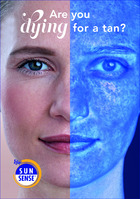Survey finds Brits are dying for a tan

Sunscreen brand, SunSense, has this week completed a nationwide tour of the UK with the aim of encouraging the public to think twice about tanning.
Utilising an ultraviolet camera, the ‘Dying for a Tan’ tour showed thousands of people the damage they may have already caused to their skin through intentional tanning.
SunSense has produced a video to highlight the dangers of tanning, using powerful footage of the Dying for a Tan campaign and live reactions to the UV camera.
Over 1,200 participants were surveyed during the tour, revealing that more than half of people believe it is safer to build a base tan before going on holiday. Ten percent said tanning beds are a safe way to tan.
Despite being told that exposure to UV rays is a major cause of skin cancer, the survey also found that nearly two thirds would overlook the long-term health risks for the sake of a sun-kissed appearance.
SunSense is now urging people to remember that any change in skin colour may be a sign that the body is trying to repair damage caused by UV rays. Skin goes brown because it has had enough UV to trigger the melanin to develop. It triggers the melanin as a defence mechanism and it may be a sign that that you have had excessive UV. Excessive UV can cause premature ageing and may lead to skin cancer.
Using a UV camera, SunSense showed people the pigmentation changes that may have been caused by sun damage that are hidden deep in the layers of skin and aren’t visible to the naked eye. Seeing the damage that has occurred had a positive impact on 70 percent of participants.
25 percent said that they would now avoid unnecessary sun exposure and 45 percent said that they might still sunbathe, but would use a higher factor sunscreen to protect their skin.
SunSense is the number one prescribed sunscreen in UK and number one in Australian pharmacy. It is a range of high factor sunscreens (SPF 50 / 50+) developed and manufactured in Australia, where standards are the most stringent in the world.
Dr Kerryn Greive PhD, Scientific Affairs Manager for SunSense comments: “There is no such thing as a healthy tan, but having one makes us feel good. Unfortunately, exposure to UV radiation from the sun and other sources, including sun beds, is a major cause of skin cancer.
“Despite this, it is difficult to get people to understand how bad a tan can be. A lot of people don’t believe that the sun is strong enough in the UK to do any real damage and even if they do, they consider skin cancer as something that happens to other people, or something that may happen in the future. But it’s the tan we are getting today that may cause skin cancer.
“Australia may be known as the skin cancer capital of the world, but it is also the first country in the world to see a reduction in skin cancer rates. This follows 30 years of public health campaigns which shows that if you are consistent with the message, you will see the benefit to people’s health.
“Skin cancer is also a serious problem in the UK and we believe that there is a lot that the UK can learn from Australia. We hope that the Dying for a Tan tour has helped to get the message across and provide the British public with the facts they need to make an informed decision about their health.”
In Australia, the advice is to combine a high factor sunscreen with sun-protective clothing, a hat that protects the face, head, neck and ears, shade and sunglasses. If people avoid unnecessary sun exposure and follow this advice when they are out and about, even on cloudy days, then the risk of premature ageing and skin cancer may be significantly reduced.
*1270 people were interviewed by SunSense UK over the course of the Dying for a Tan Tour 2015

